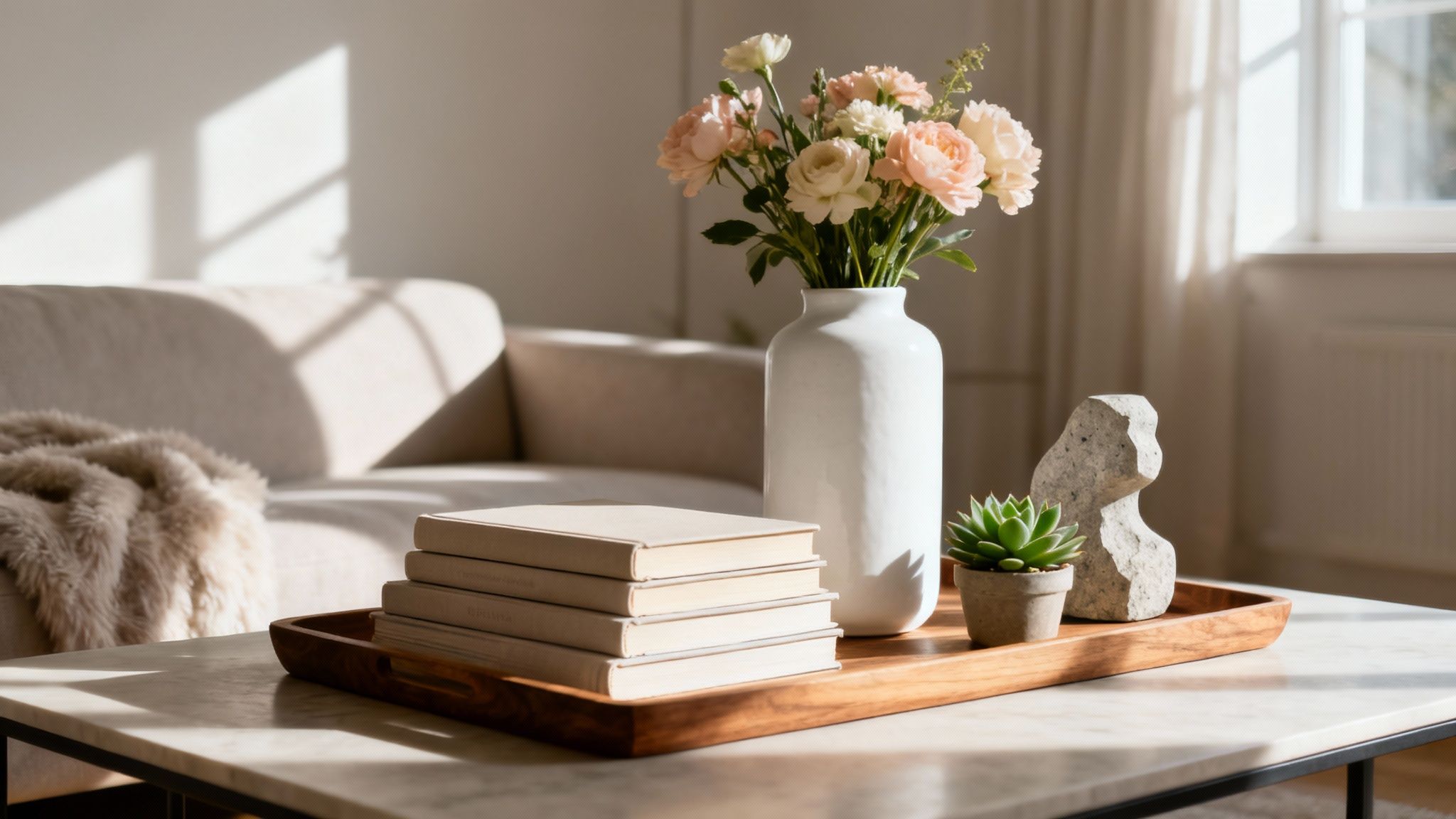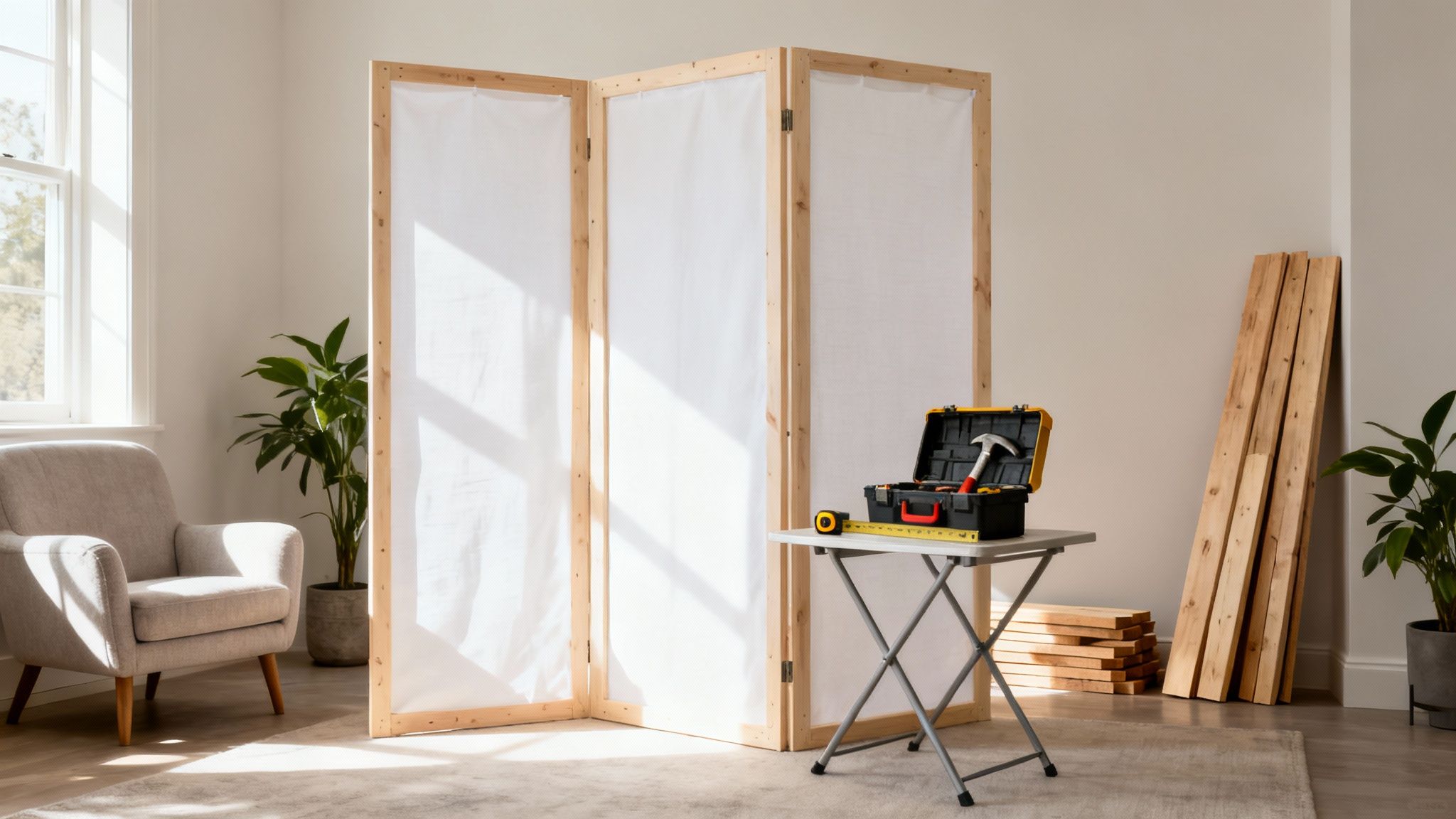Creating a garden with potted plants is a brilliant way to invite a bit of nature into any space, no matter its size. It gives you complete control over the growing conditions – from soil to sunlight – offering a kind of flexibility you just don't get with a traditional garden. This opens up the joy of gardening to everyone, whether you have a sprawling patio or just a sunny windowsill.
Why Potted Gardens Are Transforming Small Spaces
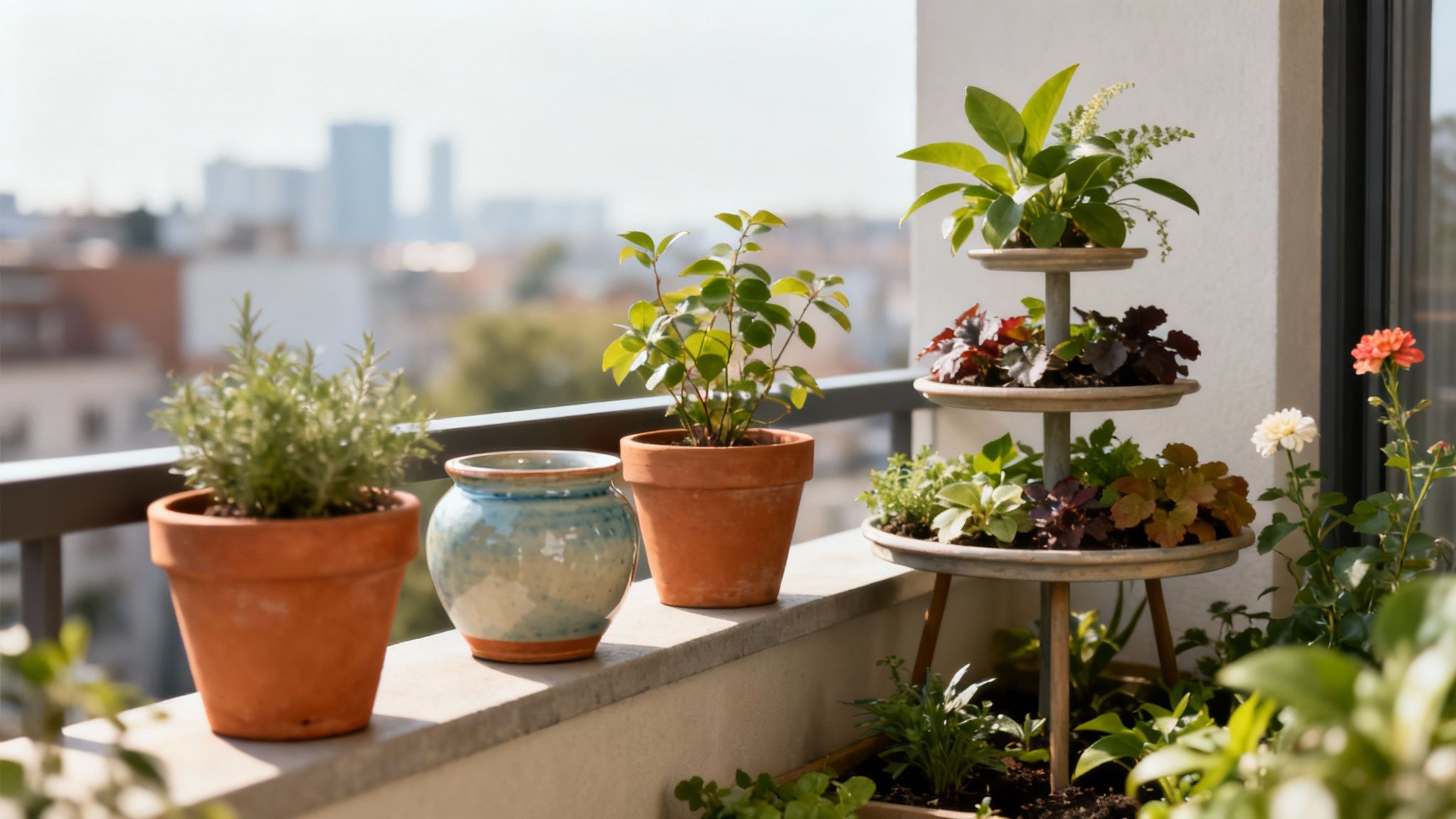
The surge in container gardening isn't just a fleeting trend; it's a genuinely practical answer to modern living. Let's face it, not many of us have a classic garden plot, but that doesn't mean the desire to grow things has gone away. Potted gardens bridge that gap perfectly, making it possible to cultivate everything from vibrant flowers to your own fresh herbs on a tiny balcony or a compact patio.
This approach really puts you in the driver's seat. You get to play soil scientist, mixing the perfect blend for each plant. Need a gritty, well-draining mix for your succulents? Easy. A rich, loamy base for your tomatoes? Done. Achieving that level of customisation in a standard garden bed can be a real challenge.
Creative Freedom and Accessibility
One of the best things about gardening with pots is the creative freedom it unlocks. You can move things around on a whim, play with different colour combinations, and completely refresh your display as the seasons change. It’s this dynamic nature that keeps your little green space feeling personal and alive.
Container gardening is also incredibly accessible. It takes a lot of the back-breaking work out of the equation – no heavy digging required – which makes it a fantastic option for people of all ages and physical abilities. Its popularity is clear from the market trends, too. Europe currently holds around 22.7% of the global potted plants market, with the UK being a major player.
The real beauty of container gardening is its adaptability. A few well-chosen pots can turn a stark, unused area into a vibrant, living oasis that reflects your personal style and brings you daily joy.
It’s also the perfect solution for renters or anyone who might move home. Your garden can simply pack up and come with you. If you’re looking for ways to make the most of a tight spot, there are some wonderfully clever ideas for very small gardens that can spark your imagination. In the end, it’s all about creating your own personal sanctuary, one pot at a time.
Choosing Containers That Help Your Plants Thrive

It’s easy to think of a pot as just a pretty accessory for a plant, but it’s so much more than that. It’s the home where your plant’s roots live and breathe. Getting the container right from the start is the secret to a successful garden with potted plants, as the material directly affects everything from moisture levels to how warm the roots get.
Let's break down the most common options. You’ve got your classic unglazed terracotta, which is porous, meaning air and water can pass through its walls. This is a game-changer for plants that hate sitting in soggy soil, like lavender, rosemary, or succulents. The soil dries out faster and more evenly, significantly reducing the risk of root rot.
On the other end of the spectrum, you have glazed ceramic or plastic pots. Since they aren't porous, they hold onto moisture for a lot longer. This makes them a fantastic choice for thirsty plants like ferns or hostas that wilt at the first sign of dryness. The trade-off is that you have to be much more mindful about not overwatering.
Material Matters More Than You Think
Modern fibreglass and composite planters have become incredibly popular, and for good reason. They're lightweight, which can be a real back-saver when you're dealing with larger shrubs or small trees. Many are also designed with built-in insulation, which is a huge plus. A big, insulated container can be the difference between a Japanese maple thriving or its roots getting scorched in a summer heatwave.
Your choice of material really comes down to balancing aesthetics with the practical needs of your plants and your local climate.
- Terracotta: A classic choice for drought-tolerant plants. Think Mediterranean herbs.
- Glazed Ceramic & Plastic: Great for plants that need consistent moisture, but be vigilant with your watering can.
- Metal Containers: They look sleek, but they heat up like an oven in direct sun. Unless they’re double-walled or placed in shade, you risk cooking the roots.
- Wooden Planters: Offer excellent natural insulation but may need a plastic liner to prevent them from rotting over time.
To help you decide, here’s a quick comparison of the most common materials you'll find.
Pot Material Comparison Guide
Choosing the right material is a big step towards setting your plants up for a long, healthy life.
Getting the Size and Drainage Right
Once you’ve settled on a material, the next critical decision is size.
One of the most common mistakes I see is a pot that's either way too big or far too small. A massive pot holds excess soil that stays wet and leads to rot, while a tiny pot restricts growth and dries out in a flash.
A good rule of thumb is to pick a pot that’s 2-4 inches wider in diameter than the plant’s current root ball. This gives it enough space to grow for a season or two without being swamped. For a vigorous, fast-growing plant, go for the 4-inch upgrade. For a slow-grower like a cactus, a 2-inch increase is perfect.
Finally, and this is non-negotiable: your pot must have a drainage hole. If you find the perfect pot but it’s missing a hole, you have two choices. You can either drill one yourself or use it as a decorative cachepot, slipping a slightly smaller pot with drainage inside. Without a way for excess water to escape, you’re basically guaranteeing root rot, the number one killer of container plants.
Mastering these basics will give you a huge advantage. If you're new to all this, diving into a comprehensive container gardening for beginners guide can help build a really solid foundation.
Selecting Plants That Flourish in Containers
Choosing the plants is, without a doubt, the best part of planning your potted garden. It’s where the vision really starts to come to life. But here's the thing: not every plant is cut out for life in a container. Your success really boils down to picking varieties that are happy with confined roots and matching them to the specific spot you have in mind.
Before you even think about heading to the garden centre, take some time to really look at your space. Is your balcony a sun trap that gets baked all afternoon? Or is it a cool, sheltered corner that rarely sees direct light? The amount of sun a plant gets is the single biggest factor for its health. A sun-worshipping lavender will just give up in the shade, while a delicate fern will get completely frazzled by a full-on solar blast.
Designing with Purpose: The Thriller, Filler, and Spiller Method
If you want to create pots that look like they’ve been put together by a professional, the classic "thriller, filler, spiller" method is your secret weapon. It’s a simple, foolproof formula for creating balanced, eye-catching arrangements.
The Thriller: This is your star player. It’s a tall, upright plant that adds height and a strong vertical line. Think of something with a bit of drama, like a spiky Cordyline or a graceful ornamental grass.
The Filler: These are your supporting actors. They’re generally more rounded, mounding plants that nestle around the thriller and fill out the middle of the pot, making the whole thing look lush and full. Geraniums, Calibrachoa, or colourful Coleus are perfect for this job.
The Spiller: These plants are the finishing touch. They are trailers that cascade over the sides of the container, softening the hard edges and tying the pot into its surroundings. Look for trailing beauties like silver Dichondra, sweet potato vine, or vibrant lobelia.
Picture this: a bold, purple Fountain Grass as the thriller, surrounded by a fluffy cloud of white petunias as the filler, with a silvery cascade of ivy spilling over the side. That single pot gives you height, volume, and elegant movement all at once.
Creating Themed Container Gardens
You don’t have to stop at designing individual pots. Why not group them together to create a specific theme? This is where your garden with potted plants can become a real reflection of your personality and passions.
A cocktail herb garden, for example, is a brilliant and incredibly useful theme for a sunny patio. Get a few pots together and plant up some mint, rosemary, basil, and thyme. They look fantastic, smell amazing, and you’ll have fresh ingredients right on your doorstep. If you’re new to growing edibles, our guide on how to grow herbs indoors has some great tips that work just as well for outdoor containers.
Another lovely idea is to create a pollinator-friendly container. Fill a large pot with flowers that bees and butterflies adore, like Salvia, Lavender, and verbena. You’ll create a buzzing little haven for local wildlife. It’s a small act that makes a big difference. This kind of gardening is clearly on people's minds, too. UK garden centres saw an estimated 203 million visits recently, with 68% of adults in the UK visiting at least once a year. It just goes to show how much we value that connection to nature. You can find out more about these gardening trends and their impact on the UK market.
By focusing on plants that are naturally compact, have shallower root systems, and match your available light, you set yourself up for a thriving, low-maintenance container garden that brings joy season after season.
Getting Your Hands Dirty: Potting and Arrangement
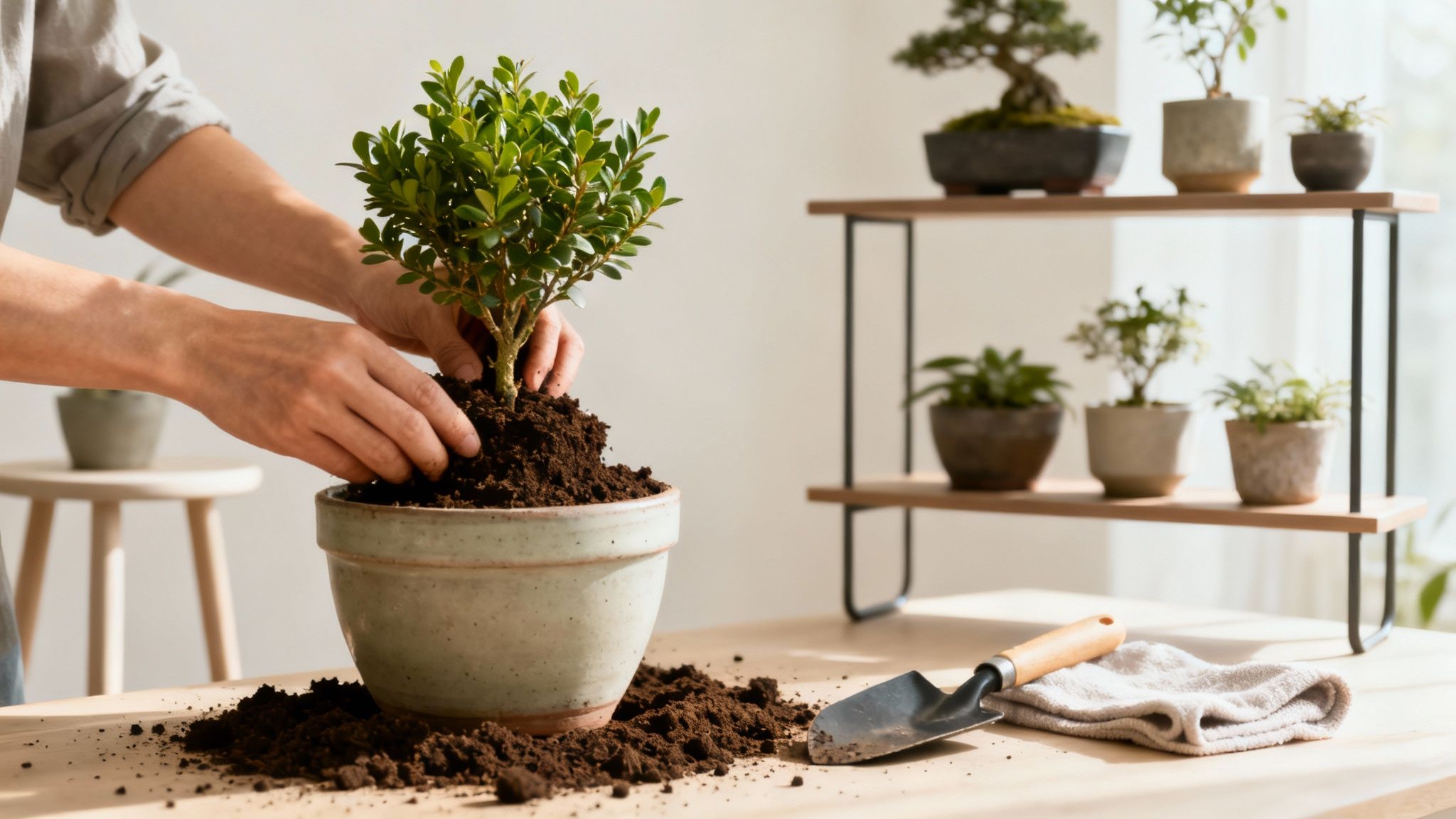
Alright, with your pots and plants picked out, it’s time for my favourite part—getting your hands in the soil. Getting a plant settled into its new home is more than just a simple transfer; you’re building a healthy environment where its roots can stretch out and thrive for years.
The first rule of container gardening, and it’s a big one, is to never use soil straight from your garden. It might seem like the natural choice, but garden soil is heavy, compacts like concrete in a pot, and is often full of pests or weed seeds you definitely don't want.
Always, always start with a high-quality, sterile potting mix. The stuff in the bag is specifically designed to be light and airy, which is absolutely vital for letting roots breathe and allowing water to drain properly.
Laying the Foundation with a Good Potting Mix
While a decent all-purpose mix will get you by, a little custom blending can make a huge difference. Don't worry, it's not complicated.
- For succulents or herbs like rosemary and lavender that hate wet feet, mix in some coarse sand or perlite to boost drainage.
- For thirsty plants like ferns or fuchsias, adding a handful of peat moss or coco coir will help the mix hold onto moisture for longer.
Think of your potting mix as the foundation of your plant's home. A solid, well-built foundation supports healthy growth, while a poor one leads to endless problems. It's truly the most important ingredient for success.
When you're ready to pot up, gently loosen the root ball of your new plant. You don't want to tear it apart, just tease the roots so they know they can grow outwards. Pop it in the container so the top of the root ball is about an inch below the rim, then fill in around the sides with your mix. Give it a good water to settle everything in, and you're off!
Creating a Living Picture with Smart Arrangement
Now for the fun part: the artistry. A single stunning pot can be a beautiful focal point, but the real magic comes from grouping containers together. This is how you get that lush, layered look that turns a boring patio into a proper green oasis. The trick is to play with height, texture, and colour.
Varying the height of your pots is the quickest way to create visual interest. You can use pot stands, an old wooden crate flipped upside down, or even a simple tiered shelf. By placing taller plants—think ornamental grasses or a climbing jasmine—at the back and shorter, mounding plants at the front, you create an immediate sense of depth.
If you're looking for clever ways to arrange planters, particularly on a deck or terrace, checking out some creative decking planter ideas can spark some brilliant inspiration.
Don't be shy about mixing and matching. A glossy, glazed pot looks fantastic next to a rustic terracotta one. Pairing the fine, delicate fronds of a fern with the big, bold leaves of a hosta makes both plants pop. When you pot and arrange with a bit of thought, you're not just growing plants—you're composing a living work of art.
Keeping Your Potted Garden Healthy and Vibrant
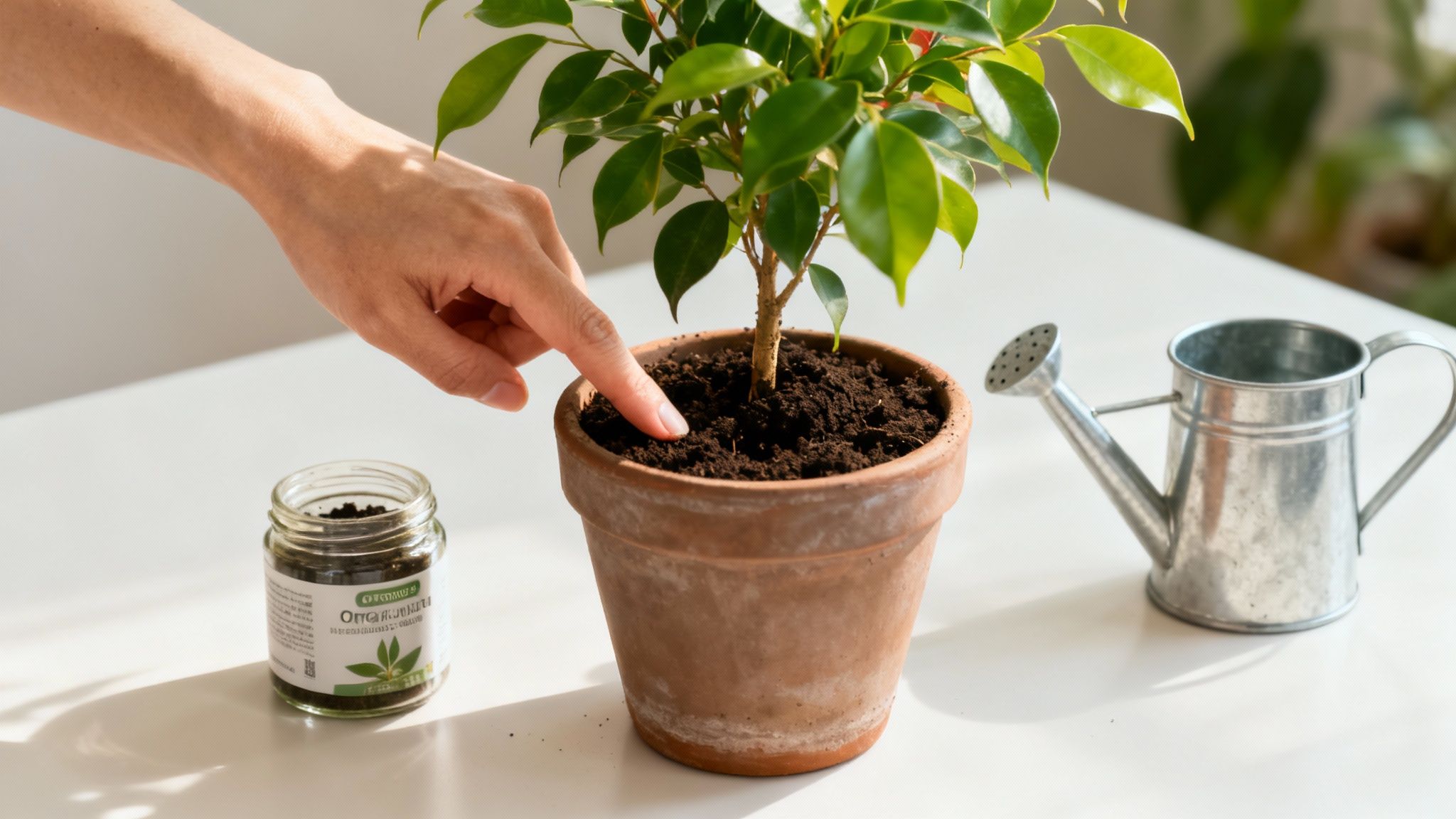
A beautiful garden with potted plants is one thing, but keeping it that way is where the real satisfaction lies. It all boils down to a few simple, consistent routines that turn a group of pots into a thriving little ecosystem. And the most important habit to master? Watering.
It might sound strange, but overwatering is probably the single biggest killer of container plants. It usually comes from a good place, but too much love can be a bad thing! The most reliable check is the good old ‘finger test’. Just poke your finger about an inch deep into the soil. If it feels dry, it’s time for a drink. If you feel any moisture, give it another day.
When it is time to water, don't just give the plants a quick splash. Water deeply and thoroughly until you see it drain out of the bottom. This encourages the roots to grow down deep into the pot, creating a much stronger and more resilient plant.
Feeding for Success and Pest Management
Unlike plants in the ground, your potted friends depend entirely on you for their food. Think of fertiliser as their meal plan for the season. For most flowering plants and veggies, a balanced liquid feed every two to four weeks during the main growing season (spring and summer) will work wonders.
You don't always have to reach for a store-bought bottle, either. Getting creative with homemade plant food is a brilliant, sustainable way to give your plants the boost they need. Another great, low-effort option is to mix some slow-release granules into the compost when you first pot them up.
A well-fed plant is a resilient plant. Proper nutrition not only fuels vibrant growth and blooming but also strengthens a plant's natural defences against common pests and diseases.
Even with the best care, you’ll probably run into a few pests now and then. Don't panic! Here are a few simple ways to tackle the usual suspects:
- Aphids: Often, a sharp blast of water from the hose is all it takes to send them packing. If they’re a bit more stubborn, a weak solution of washing-up liquid and water sprayed onto the leaves usually does the trick.
- Spider Mites: These tiny critters hate humidity, so regular misting can make your plants a much less inviting home for them.
- Slugs and Snails: A strip of copper tape stuck around the rim of your pots creates a barrier they really don't like to cross. It’s surprisingly effective.
Preparing for the Colder Months
A little winter prep goes a long way to making sure your garden bounces back beautifully next spring. For any tender perennials, shifting them to a sheltered spot—like against the wall of the house or into a greenhouse—can save them from the worst of the frosts. You can also give the roots extra protection by wrapping the pots in bubble wrap or hessian.
This kind of hands-on gardening is part of a much bigger picture. There are around 330,000 allotment plots across the UK, which just goes to show how much we love to grow our own. Creating a garden with potted plants is your own personal, accessible version of this wonderful tradition.
Got Questions About Your Potted Garden? We've Got Answers
Even the greenest of thumbs runs into questions. As you get to know your plants, you'll inevitably face a few head-scratchers. It’s a natural part of gardening! We've gathered some of the most common queries right here to help you solve those little mysteries and keep your container garden thriving.
Think of this as a chat over the garden fence, where you get straightforward advice for when you're standing there, watering can in hand, wondering what to do next.
How Often Do My Plants Need Repotting?
This is a classic one. A good rule of thumb is that most container plants will appreciate a new home every 1-2 years. But don't just mark your calendar; your plant will give you some pretty clear clues when it's feeling cramped.
Are roots starting to sneak out of the drainage holes? Does the soil dry out in a flash, much quicker than it used to? These are tell-tale signs that the root system has filled the pot, a condition known as being 'pot-bound'.
When you do move it to a new home, don't go overboard with the size. It's tempting to give it loads of room, but a pot that's just 1-2 inches wider in diameter is ideal. This simple step prevents the soil from staying soggy for too long, which is a leading cause of root rot. Always treat your plant to fresh, high-quality potting mix to give it a nutrient boost for its next chapter.
What’s the Smartest Way to Water a Lot of Pots?
When your collection of pots starts to grow, watering can feel like a full-time job. The key is to work smarter, not harder. Start by grouping plants with similar watering needs together. Your succulents and other drought-tolerant friends can hang out in one area, while thirsty ferns and flowering annuals live in another. This immediately streamlines your routine.
A long-spouted watering can is brilliant for getting water right to the base of the plant without drenching the leaves. For a larger garden with potted plants, though, a drip irrigation system can be a real game-changer. Setting it up on a timer delivers a slow, steady supply of water directly to the roots, which is incredibly efficient and keeps your plants consistently hydrated.
Whichever method you land on, the old-fashioned 'finger test' is still the gold standard. Before you water, stick your finger an inch into the soil. If it comes out dry, it's time for a drink. This one simple habit is the best defence against the number one plant killer: overwatering.
Can I Actually Grow Veggies in Pots?
You absolutely can! A container vegetable patch is not only possible but also immensely satisfying. Plant breeders have developed fantastic varieties specifically for smaller spaces. When you're shopping, keep an eye out for terms like 'compact', 'dwarf', or 'bush' on the tags for things like tomatoes, peppers, and cucumbers.
Leafy greens like lettuce and spinach are practically made for pots, as are fast-growing radishes and almost any herb you can think of. As a guide, a single tomato plant will need at least a 5-gallon pot to thrive, giving its roots enough space to support a healthy harvest. Just make sure you use a potting mix designed for vegetables and find a spot that gets a solid 6-8 hours of direct sun daily. That's the real secret to success.


